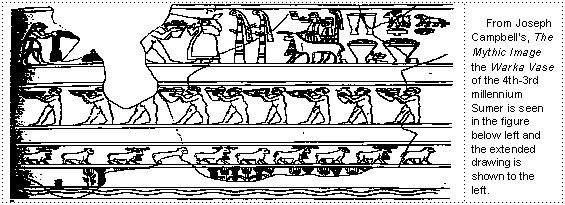
The Warka Vase, is the oldest ritual vase in carved stone discovered in ancient Sumer and can be dated to round about 3000 B.C. or probably 4th-3rd millennium B.C. It shows men entering the presence of his gods, specifically a cult goddess Innin, represented by two bundles of reeds placed side by side symbolizing the entrance to a temple. Inanna in the Middle East was a Earth and later (horned) moon goddess; Canaanite derivative of Sumerian Innin, of Ishtar of Uruk. Ereshkigal (wife of Nergal) was Inanna’s (Ishtar, Astarte, Aphrodite, Venus) elder sister. Inanna descended from the heavens into the hell region of her sister-opposite, the Queen of Death, Ereshkigal. And she sent Ninshubur her messenger with instructions to rescue her should she not return. The seven judges (Annunaki) hung her naked on a stake. Ninshubar tried various gods (Enlil, Nanna, Enki who assisted him with two sexless creatures to sprinkle a magical food and water on her corpse 60 times). She was preceded by Belili, wife of Baal (Heb. Tamar, taw-mawr', from an unused root meaning to be erect, a palm tree). She ended up as Annis, the blue hag who sucked the blood of children. Amaterasu (Japanese goddess of the sun) is an Oriental sister of the great Inanna. Inanna in Egypt became the goddess of the Dog Star, Sirius which announced the flood season of the Nile which will be discussed later in this chapter.



Also the reed images on the Warka Vase is similar to the Pharaoh staff (an ancient sign or hieroglyph for ‘god,’ ntr represents "a staff bound with cloth") seen later and the Vase itself is similar to a vessel (UC 16947) found with the findings of the Egyptian King Scorpion as seen below.